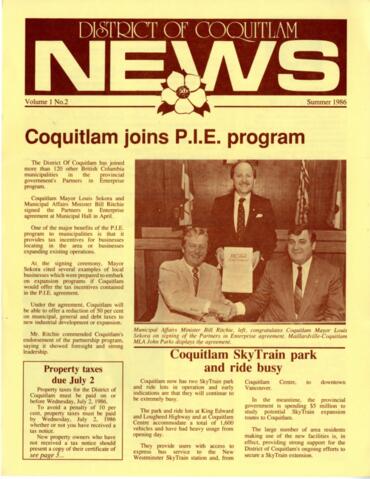Zone du titre et de la mention de responsabilité
Titre propre
District of Coquitlam News, Summer 1986
Dénomination générale des documents
- Document textuel
Titre parallèle
Compléments du titre
Mentions de responsabilité du titre
Notes du titre
Niveau de description
Pi?ce
Cote
Zone de l'édition
Mention d'édition
Mentions de responsabilité relatives à l'édition
Zone des précisions relatives à la catégorie de documents
Mention d'échelle (cartographique)
Mention de projection (cartographique)
Mention des coordonnées (cartographiques)
Mention d'échelle (architecturale)
Juridiction responsable et dénomination (philatélique)
Zone des dates de production
Date(s)
Zone de description matérielle
Description matérielle
1 document : 21 x 28 cm
Zone de la collection
Titre propre de la collection
Titres parallèles de la collection
Compléments du titre de la collection
Mention de responsabilité relative à la collection
Numérotation à l'intérieur de la collection
Note sur la collection
Zone de la description archivistique
Nom du producteur
Histoire administrative
Colonial settlement of the area between New Westminster and Pitt River along the Fraser began in the 1920s in the pursuit of trapping, fishing, and logging. Industry and more intensive colonial settlement began with the opening of the Fraser Mills sawmill on the north bank of the Fraser in the last years of the 19th century.
Coquitlam comprised an area of approximately sixty-five square miles that had been surveyed by Royal Engineer A.L. Breakenridge in 1863. In the late 1880s, the landowners and pre-emptors living in the area petitioned the province to incorporate as a Municipal District.
The area was incorporated by letters patent dated July 25, 1891 as the Corporation of the District of Coquitlam. The letters patent called for the nomination of five councillors and a reeve and the first meeting of a municipal council were assembled in Kelly’s Hall on August 22nd, 1891 at Westminster Junction, now within the City of Port Coquitlam. The first reeve was R.B. Kelly and the first councillors were E.A. Aitkins, James Fox, S.W. Lehman, James Morrison, and J. Shennan. The first City Clerk was R.D. Irvine.
In 1894, a portion of the Maple Ridge Municipality between the newly formed Corporation of the District of Coquitlam and the Pitt River was added to the Coquitlam municipality, following a petition by the landowners to the province.
In 1913, the land owners in the area known as Westminster Junction wished to limit their tax liability for the development of the rapidly growing district and to establish their own tax base. A petition was sent to the province and the area seceded from the Corporation of the District of Coquitlam, forming the City of Port Coquitlam.
In the same year, The Canadian Western Lumber Company decided to incorporate the area surrounding Fraser Mills and the Corporation of the District of Fraser Mills was incorporated by letters patent in 1913. The Corporation of the District of Coquitlam and the Corporation of the District of Fraser Mills amalgamated in November 1971, when both districts revoked their letters patent and new letters patent was issued incorporating the area as the District of Coquitlam. Supplementary letters patent were issued in 1973 and 1986 to reflect changes in municipal boundaries.
Effective December 1, 1992, the District of Coquitlam’s status was changed by new letters patent to that of a city municipality and it became known as the City of Coquitlam. Today, it is bordered by the municipalities of Port Moody, Port Coquitlam, Burnaby, and New Westminster as well as the Fraser River to the south, the Pitt River to the east, and the Coastal Mountains to the north. It includes the community of Maillardville, a region near Fraser Mills settled by French Canadians in the early part of the 20th century.
History of the municipality’s bylaws indicates both the perceived remoteness of the region and its rapid urbanization. Road taxation began in 1897, the sale of liquor was first regulated in 1909, and municipal health regulations were first passed in 1912. Coquitlam had electricity by 1911, and plans for running water began in 1916. The building of a separate fire hall in 1946 and expansion of water service in the mid-1950s indicate a particularly vigorous period of population growth. The municipality assumed responsibility for paved roads and sidewalks by 1961. Zoning changes in the 1970s and 1980s reflect a change in land use from agricultural to single-family suburban residential and low-density apartment housing. An average of two development permits was issued every month by the early 1980s.
The town centre, developed in the 1980s and 1990s, provides cultural and recreational facilities and includes the Coquitlam Centre Mall, the Evergreen Cultural Centre, the Public Safety building, City Hall, the Pinetree Community Centre, the City Centre Aquatic Complex, the Coquitlam Public Library, the City Archives, and Douglas College. The population of Coquitlam has more than doubled from the 1970s to the present day.
City Clerks, District and City of Coquitlam
R.D. Irvine 1891-1899
John Smith 1899-1913
A. Haliburton 1913-1917
Robert Newman 1918-1927
Alan M. Shaw 1928
William Russell 1928-1947
F.L. Pobst 1947-1972
R.A. Leclair, acting clerk, 1965, 1966 1967
H.F. Hockey, acting clerk, 1967
Ted Klassen, acting clerk, 1967
Ted Klassen, 1972-1991
Sandra Aikenhead, 1991-1994
Warren Jones, 1994-2000
Trevor Wingrove, 2000-2002
Sonia Santarossa, 2002-2008
Jay Gilbert, 2008-present
Reeves and Mayors, District and City of Coquitlam
R.B. Kelly 1891-1896
E.A. Atkins 1897-1903
Ralph Booth 1904-1908
D.E. Welcher 1909-1910
James Mars 1911-1913
L.E. Marmont 1918-1922
George H. Proulx 1923
R.C. MacDonald 1924-1941
J.W. Oliver 1942-1944
L.J. Christmas 1945-1969
J.L. Ballard 1970-1971
James L. Tonn 1972-1983
Louis Sekora 1984-1998
Jon Kingsbury 1998-2005
Maxine Wilson 2005-2007
Richard Stewart 2008-present

